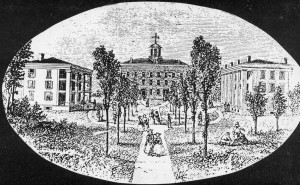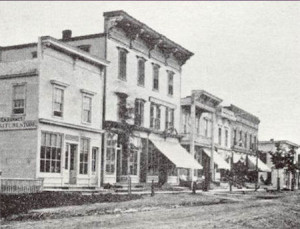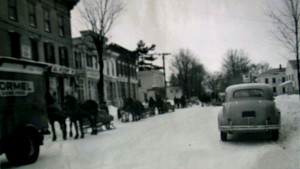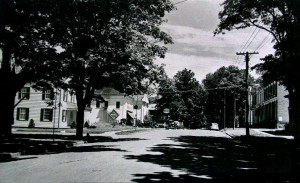About the Greater Franklin NY Chamber of Commerce
The Greater Franklin NY Chamber of Commerce serves Franklin, Treadwell, Otego and the surrounding area.
The Greater Franklin Chamber of Commerce is on hiatus. There is interest in reviving this business group. If you would like to get involved, please get in touch.
The Franklin Chamber is not currently active. There are many good organizations in Franklin and Treadwell, here are a few:
- Bright Hill Press
- Franklin Central School District
- Franklin Community Education Foundation
- Franklin Edible Walking Trail
- Franklin Farmers’ Market
- Franklin Free Library
- Franklin Improvement Society
- Franklin Local
- Franklin NY Rotary
- Franklin Railroad and Community Museum
- Franklin Stage Company
- Franklin Village Park
- Greater Franklin Food Pantry
- Ouleout Valley Cemetery
- Stagecoach Run Art Festival
- Town of Franklin NY – official website
- Village of Franklin NY – official website
About the Town of Franklin NY
The Town of Franklin lies in the northern part of Delaware County, New York State. It is bordered by Otsego County on the north, the town of Davenport, and Meredith on the east, the towns of Delhi, Hamden, and Walton on the south, and the town of Sidney on the west. Franklin presents a view of wooden hills, streams, ponds, old homes, and commerical buildings, and numerous winding roads. The hills are Devonian age sedimentary rocks that slope gently to the south, gray-green or red mudstones, siltstones, and sandstones. Its surface is hilly upland made of shallow shaly loam atop glacial till (hardpan), while the valleys consist of deeper gravelly loam atop moraines, kames, outwash and alluvium.
Little is known of the area prior to the American Revolution. It was a wilderness visited by different Indian tribes, colonial hunters and trappers. Various land patents were bought sight unseen by speculators who were lured by dreams of profit taking. Hundreds of settlers had moved into the Harper’s Patent.
On April 10, 1792 the State Legislature passed An Act For Dividing the Several Towns
…That all that part of the town of Harpersfield, lying south of a line to be drawn, beginning at the south easterly bank of the river Susquehannah, from thence running a south easterly course to the north west corner of others, thence running on the north east line of Whites-Borough until it comes to the Cachquago branch of the river Delaware, thence down the said river to the line of property, thence along the said line of property, until it comes to the river Susquehannah, opposite to the river Unadilla, thence up the said river Susquehannah, to the place of beginning, shall be and hereby is erected into a town, by the name of Franklin, and that the first town meeting shall be held at the house of Sluman Wattles Esquire, in the said town…
Franklin is the most common place name in the United States. Six men, including William Frankin, eldest son of Benjamin Franklin, owner 30,000 acres east of the Town of Franklin named the Franklin Patent. The new town of Franklin underwent several changes. In 1798 part of the town became Walton. The law also provided that Franklin and Walton would divide “existing money and poor people”, as shall appear most equitable to the major part of them. Later town lines were further adjusted as a part of Meredith was taken off in 1800, Sidney in 1801, and the “Huntsville”, portion of Otsego in 1822. Franklin was originally part of Otsego County, however on May 30, 1797 the first annual meeting of the Board of Supervisors was held at Gideon Frisbee’s house to proceed with the formation of Delaware County. Franklin and six other towns were represented at this meeting.
In 1800, Franklin’s first census showed a population of 1,390. Most of the people who were not clearing isolated land were clustered in settlements at Bartlett Hollow and Leonta. On September 30, 1800, Franklin became the first post office in the country with Elias Osborn as its new postmaster. Sluman Wattles was the first settler in 1785, followed by Nathaniel Edgerton, James Follett, Alex Smith, Enos Parker, Asa Turner, and hundreds of others. The land yielded pine, beech, maple, oak, hickory, and chestnut. Lumber was carted to the Delaware and Susquehanna, where it was rafted to the cities. Large amounts of grain were harvested. As in many frontier comunities, distilleries converted the surplus into thousands of barrels of whiskey, which were shipped to Philadelphia and New York. A local market for pork developed, while cattle drovers moved their herds eastward along the newly formed Catskill and Susquehanna Turnpike. This toll road spurred trade between Catskill and Wattle’s Ferry. Towns along this eighty-nine mile road grews as taverns, hotels, liveries, and other facilities developed to support the endless movement of wagons, animals, and people. The villages of Franklin and Treadwell (formerly Jug Town and Croton) prospered. Strong ties with agriculture also grew as the villages served the growing needs of farmers.
Throughout the 19th century, Franklin had to adapt to changes in agriculture. Raising sheep and processing wool surpassed grain and cattle before the Civil War. The Catskill Turnpike declined as canals and railroads successfully completed for business.
Despite this loss of trade, Franklin continued to grow in population and experienced growth of its institutions as well in business. In 1793, the Baptist and Congregational Churches organized and remained notable religious influences in Franklin. In 1833, decades of circuit riding preacher visits ended with the establishment of the Methodist Church. By 1865, there were eight churches in town: two Baptist, one Congregational, three Methodist, one Presbyterian, and one Episcopal.

The 1835-36 years found some long term changes beginning. A new well-engineered road between Franklin and Oneonta was organinzed and financed through the sale of $25 shares in the Franklin & Oneonta Turnpike Company. The village of Franklin became the town population center, especially after John Edgerton’s purchase of 100 acres and subsequent street and lot layouts in 1827. In 1836, the village became incorporated. Education had its beginning in town with a schoolhouse in Bartlett Hollow. By 1840, there were 25 school districts in Franklin. Many Franklinites felt that additional schooling was needed. Accordingly, a grant of incorporation for an institution of learning called the Delaware Literary Institute was approved by the state legislature in 1835. In time, three large buildings – Stone, Ladies, and Chapel Halls were built with financing by Franklin’s citizens. Local students and others from different states paid tuition at this well-received school. The Civil War and growing tax support for public schools brought about a declin e in attendance, with the eventual decision to deed all of D.L.I.’s facilities to District 10. With centralization in 1929, the Franklin Central School was created. The following year voters authorized the official name of the school to be Delaware Literary Institute and Franklin Central School, thus preserving part of the past.
By 1860, the census showed that there were 3,308 people in the town. Franklin village streets showed many fine residences built in the Federal, Greek Revival, Italiante Revival and Gothic styles. Main Street bustled with commercial activity.
Printer George W. Reynolds published and edited Franklin’s first newspaper, THE WEEKLY VISITOR, from 1855 to 1863. It was succeeded by the FRANKLIN REGISTER, 1868-1883, which changed to the DELAWARE COUNTY DAIRYMAN, in 1883-1952. The First National Bank of Franklin was founded in 1863, Amos Douglas being its first president. This bank served the community until 1933.
Franklin’s support of the military dated from 1792, when a local militia was formed. During the War of 1812, three companies of Franklin men served at Sackett’s Harbor and New York City. In 1845, Franklin’s militia were called out to guard Delhi during the Anti-Rent crisis. Civil War records indicate that 318 men served different periods of enlistment in Franklin’s Company D of the 144th Regiment, or in filling other Delaware town quotas. Franklin men have continued to serve in all of this nation’s wars.

In the aftermath of the Civil War many social and economic changes occurred in Franklin. Agriculturally, dairying took on increasing importance, with milk, butter, and cheese, all showing production increases. A creamery association was formed to develop and market dairy products. In addition to licensed taverns, inns, and hotel, the business directory included dry goods, hardware, furniture, grocery, druggists, carriagemakers, coopers, harness makers, shoemakers, foundry, cigar company, telegraph, ice cream parlor, marble works, doctors, dentists, lawyers, and other vocations.
The railroad bi-passed Franklin, except for the Ontario & Western’s Franklin Depot. When the trustees of the D.L.I. voted to ask the Board of Regents to establish teacher training at the school, the end result was the founding of a Normal School in Oneonta. A gradual decline in population continued through the first half of the 20th century when the trend reversed itself.

While numerous burial grounds are to found within the town, it is the Ouleout Valley Cemetery on Route 357, begun in 1873, that often draws attention to its handsome iron gate and well manicured grounds. The massive Erastus Edgerton Monument is impressive, but the Soldiers’ Monument where annual Memorial Day observances have been held since its dedication in 1889, is reverved in Franklin history.
Many of the community organizations were started in the 19th century. The Fire Department, Masonic Lodge, Odd Fellows Lodge, Sportsmen’s Assocation, Washington Reading Circle, and Onesiphori, and the Free Library contributed to Franklin’s way of life.
Treadwell and Franklin also experienced strong chapters of the W.C.T.U. and the Good Templers, in response to the preceived excessess of “Demon Rum”. In the last century, local sales of alcoholic beverages were controlled through the issuance of licenses by town government. The fees collected were often used to aid the less fortunate. Franklin continues to be a “dry” town.

In 1990, the census showed the Town of Franklin with a population of 2,471, with 409 in the Village of Franklin. The number of active farms continued to decline, absentee ownership increased, few new businesses survive, a substantial number of people retired or commuted to work. Franklin Central School completed a building program in 1991. In 1983, the Village of Franklin was placed on the National Registry of Historic Places. This noteworthy honor was a memorable beginning in the continued preservation of Franklin’s architectural treasures.
In 1992, the Town of Franklin celebrated its bicentennial with many events. On July 25, 1992, dozens of groups marched along Main Street in the bicentennial parade, which was videotaped for later viewing. The Ouleout Valley Historical Society published Throughout the Years in the Town of Franklin 1792-1992.
